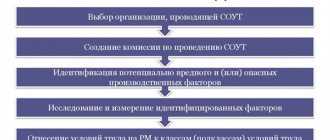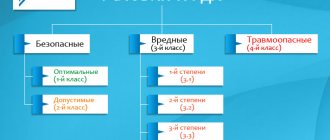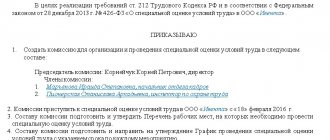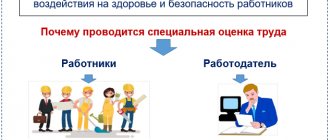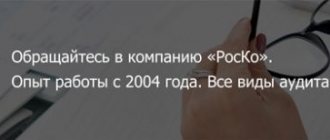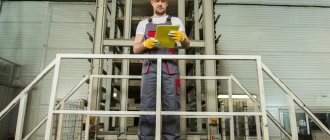A special assessment of working conditions is provided by law for each workplace by the employer (Article 212 of the Labor Code of the Russian Federation). The purpose of the special assessment is to establish and document the risk class and level of harmfulness of working conditions, taking into account the use of employee protective equipment purchased by the employer. The facility survey procedure includes a detailed analysis of individual production facilities or a group of similar locations. Their list is agreed upon at the preliminary stage, and the procedure is regulated by the law on special assessment dated December 28, 2013 No. 426-FZ.
Declarations on SOUT: regulatory framework
The rules for filing the SOUT declaration are enshrined in Federal Law No. 426 “On special assessment of working conditions” dated December 28, 2013. Experts from the Ministry of Labor decided to make life easier for employers and prepared a bill recognizing the declaration as unlimited . It is currently being reviewed by officials, so it is impossible to say whether it will be approved or not.
Fragment of the draft amendments to Federal Law No. 426 dated December 28, 2013
Before amendments to the law, the validity period of the SOUT declaration is 5 years . If no violations have been identified in the company, no occupational diseases have occurred among employees, labor safety requirements have not been violated, and no accidents have occurred, the SOUT declaration is automatically extended for another 5 years. This procedure is enshrined in Letter of the Ministry of Labor No. 15-1/OOG-1968 dated August 30, 2019.
After 10 years, employers are required to re-assess working conditions and submit a declaration of labor conditions. According to officials, canceling the validity period of the document will reduce pressure on employers and reduce material costs. If the bill is approved, the new rules will come into force on January 1, 2021.
Help: if an accident occurs in an organization within 5-10 years, violations or global changes are detected, the declaration is automatically canceled.
In this case, the employer is forced to conduct an unscheduled assessment and transmit current information to the State Tax Inspectorate.
In what order is SOUT carried out?
The procedure for carrying out SOUT is set out in Chapter. 2, Art. 8 of Federal Law No. 426. The stages are as follows:
- organization and general preparation;
- identification of hazards and potential dangers at the place of work;
- study and detailed measurement of hazards;
- studying the conditions of a specific place of work;
- report preparation;
- filling out the declaration.
The final information and report to the Ministry of Labor on SOUT are submitted by the organization that conducted the special inspection.
Why submit a declaration to assess working conditions
First of all, filing a declaration is in the interests of the employer. Using the report, you can prove the fact that employees work in acceptable conditions, thereby reducing the amount of insurance premiums and refusing to provide benefits and guarantees.
If harmful or dangerous factors are identified in the company, the employer is obliged to pay additional insurance premiums of up to 8%. The allowance is calculated in accordance with Order of the Ministry of Labor No. 33n dated January 24, 2014. Keep in mind that if you eliminate negative factors, after an extraordinary or regular special assessment, you will be able to reduce your financial burden. The exception is organizations that previously had a hazard class of 4.
Amount of additional insurance premiums depending on working conditions
| Working conditions | RM class | % premium |
| Optimal | 1 | 0 |
| Acceptable | 2 | 0 |
| Harmful | 3.1 | 2 |
| 3.2 | 4 | |
| 3.3 | 6 | |
| 3.4 | 7 | |
| Dangerous | 4 | 8 |
Responsibility for refusal to submit the SOUT declaration
Refusal to submit a declaration or late submission of a report will result in administrative liability. The amount of the fine is regulated by Art. 5.27.1 Code of Administrative Offenses of the Russian Federation. Thus, in 2021, for the first violation, fines of up to 80,000 rubles are , for a second violation - up to 200,000 rubles or suspension of activities for up to 3 months.
Submission rules
The order of the Ministry of Labor fixed the ways of sending a declaration on SOUT to the labor inspectorate (TI):
- submit a declaration in paper form when visiting the inspection;
- send the document by Russian Post. The letter is in registered form, be sure to include a receipt receipt and a list of the contents of the envelope;
- submit the SOUT declaration electronically on the labor inspectorate website;
- The form is signed with the digital signature of the company management before sending it.
Where to submit SOUT reports
Let's see where to submit the SOUT declaration. The document is sent to the TI at the place of registration of the company. During the special inspection, the workplaces of working employees in the company, including offices, are checked. The employer finds out how comfortable it is for employees to work, and if the conditions are recognized as comfortable, it acquires the right to pay contributions at low rates. During the special assessment, factors that negatively affect people are taken into account, and not aesthetic components. The expert assesses the level of noise, dust or lack of proper lighting. The color of the walls and the quality of window and door fittings are not taken into account. They measure the severity of labor, chemical and biological factors.
Assessments can be carried out by accredited persons. They have special equipment and skills. The company does not have the right to organize SOUT independently. The SOUT contractor is accredited, its accuracy is checked on the website of the Ministry of Labor. The appraiser's certificate is verified there.
The cost set by appraisers depends on the specifics of the company’s work and the total number of places. Traveling to sites outside the city is more expensive. When assessing manufacturing companies, additional measurements of the noise level and severity of technological processes are required, therefore, the cost increases. Also, the shorter the execution time, the higher the price.
Before the assessment activities, a list of places that are planned to be assessed is drawn up and signed by the commission. They create an order for the implementation of SOUT, draw up a schedule of activities. There is no special form for the schedule; it is compiled in any form according to the company’s internal document flow regulations. The schedule, list and order are stored in the accounting department.
Who submits a declaration for a special assessment of working conditions
Who should conduct a special assessment of working conditions in the organization? The document is provided by the company or its representative by proxy. The declaration on the special assessment of working conditions was introduced by order of the Ministry of Labor dated February 7, 2014 No. 80n. The company fills out and sends a declaration to the state labor inspectorate at its location within thirty days from the date of signing the special assessment report. TI reviews the report within ten working days and, if everything is filled out correctly, approves and registers it. If the declaration is filled out incorrectly, it is sent to the company with comments.
The declaration is not submitted:
- in places of workers included in the lists of the Cabinet of Ministers Resolution No. 10 of January 26, 1991;
- at work that allows you to receive an old-age insurance pension beyond the established deadlines;
- where a compensation package is provided for work with negative performance factors;
- where factors adversely affecting workers are recorded.
If no tragic cases or occupational diseases are recorded at the declared workplaces in the next five years, then the validity of the declaration will be extended for another five years. Consequently, companies are exempt from the SLA for a period of five years. When an accident is recorded, the company organizes a special assessment outside the plan, and the current declaration is canceled.
How often do you need to declare jobs?
The materials of the SOUT report are valid 5 years after the inspection. The company organizes a special assessment for newly created jobs.
Form for an updated declaration on SOUT
The company's declaration is sent within thirty working days after the acceptance of the SOUT report. The declaration on the special assessment of working conditions and when it must be submitted is recorded in paragraph No. 5 of the procedure implemented by order of the Ministry of Labor and Social Protection of the Russian Federation dated February 7, 2014 No. 80n.
How to submit a SOUT declaration
You must submit a declaration of assessment of working conditions according to the Special Labor Conditions to the state labor inspectorate at the place of registration of the organization. This can be done either by the employer himself or by a trusted representative. The maximum period for submitting a report is 30 days from the moment the document was approved and the data was entered into the FSIS SOUT system.
There are several ways to submit a declaration to the State Tax Inspectorate:
- in paper form in person when visiting the inspection;
- in electronic form on the official website of the Federal Labor Service;
- by mail with a description of the contents and notification of delivery.
After receiving the declaration, the department carries out an inspection. The duration of document review varies. As a rule, it takes no more than 10 working days to approve a declaration of a special assessment of working conditions.
If there are no errors, the State Labor Inspectorate will accept and register the report in the Register of Declarations for a Special Assessment of Working Conditions . If errors are found, you will have to correct them and submit a new report. Be careful not to miss deadlines, otherwise late fees may apply.
How to use it at work
The employer must notify both the organization that conducted the special assessment (within 3 days) and the employees (within 30 days) about the approval of the report. The company itself, with the help of the document, in the next 5 years (the “validity period” of the special assessment) will work to maintain and improve the level of safety of working conditions.
If the research reveals hazardous production factors, the employer will have to work to provide guarantees to employees who work in hazardous conditions. This is about:
- provision of additional compensation (reduction of working hours, additional annual leave);
- providing workers with PPE;
- carrying out measures to improve working conditions (modernization of production, installation of additional air purification systems).
Let us remind you that within 30 days from the date of approval of the report, its text must be published on the official website of the organization, if there is one.
Features of filling out a declaration for assessing working conditions
The declaration form was approved by Order of the Ministry of Labor of Russia No. 80n dated 02/07/2014, but when filling it out, it is necessary to take into account the amendments made by Order of the Ministry of Labor of Russia No. 642n dated 11/14/2016. In general, filling out the report is not difficult; the main thing is to make sure that there are no errors, blots or typos.
The declaration must be completed for all workplaces , even if they have optimal or acceptable working conditions. You may not include in the report those places where work initially implies early retirement, benefits and guarantees. If, based on the results of previous certifications, harmful or dangerous factors were identified, but you did not eliminate them, you also do not need to report.
Contents of the SOUT declaration
- Full or abbreviated name of the organization, for individual entrepreneurs - full name of the individual entrepreneur.
- Personal information of the manager.
- Exact address, as in the statutory documents. For branches that operate without forming a legal entity, the address of the main division.
- OGRN or INN codes.
- List of declared jobs indicating positions, specialties and codes.
- The number of employees.
- Workplace numbers based on the SOUT map.
- Marking with the letter A similar places.
- Results of SOUT.
- Details of the expert opinion.
- FULL NAME. specialist who conducted the special assessment and compiled the report.
Sample declaration of conformity “Special assessment of working conditions”
Note! The electronic SOUT declaration contains the same information as the paper one.
Who draws up the document and what is written in it
Although the results of checking working conditions at workplaces are drawn up by the organization that conducted the special assessment of the employer, the report on the conduct of the special assessment is signed by all members of the commission who participated in the research, and it is approved by the chairman of the commission (Article 15 of the Federal Law of December 28, 2013 No. 426- Federal Law). In fact, the report must be approved by the head (representative) of the company where the SOUT was carried out, since only he has the right to head the expert commission.
The report includes (mandatory minimum):
- information about the organization that conducted the special assessment;
- a list of workplaces where it was carried out;
- identified harmful production factors;
- protocols for conducting research and measuring identified hazardous factors;
- special assessment cards, in which the expert of the organization conducting the special labor assessment indicates the class (subclass) of working conditions at specific workplaces;
- summary statement of special assessment;
- conclusion of an invited expert.
Additionally, the following may be attached to the report:
- protocol for assessing the effectiveness of PPE used by employees who work in hazardous conditions, if such testing was carried out;
- if a decision was made about the impossibility of assessing harmful production factors in accordance with clause 9 of Art. 12 of Law No. 426-FZ, a corresponding protocol of the commission is needed;
- in relation to workplaces where dangerous and harmful production factors have been identified, a list of measures to improve the working conditions and safety of workers will need to be approved and attached to the report;
- special reasoned opinion if one or more members of the commission do not agree with the conclusions of the external expert.
Types of SOUT
There are two of them:
- planned;
- unscheduled.
Planned special assessment of working conditions
carried out in accordance with established legislation once a year. All jobs are assessed. The planned SOUT may be phased. But everything depends on the conditions of production activity. In some cases, conducting a job assessment in several stages is prohibited by law.
An unscheduled SOUT is carried out in such cases
:
- The company has created new workplaces that have not yet been certified and tested, but the technological process has already been organized for them.
- Production processes led to the occurrence of occupational diseases among employees.
- A fatal or serious work-related accident has occurred at work.
- The employer began to use new personal protective equipment to ensure the safety of its employees.
- The trade union organization put forward demands for an unscheduled SOUT.
- The company changed production conditions and technological processes. They may result in harm to the health of the employee.
According to the law, the company must conduct an unscheduled inspection of working conditions no later than 6 months after the need arises.
Im:
Unscheduled inspections of workplaces that have not yet been equipped are not carried out.
For violation of the law, administrative liability is provided in the form of fines.
What will the employer additionally receive from the appraiser company starting from 2021?
Starting from 2021, the appraiser company will be obliged to inform the employer about the fact of sending information about the special assessment carried out at his enterprise to the FSIS SOUT. This is given 3 working days from the moment such information is sent (Part 3 of Article 18 of Law No. 426-FZ).
This obligation will be considered properly fulfilled only if the employer receives a notification from the appraiser company in one of the forms specified in the law:
- in the form of a paper notice delivered by registered mail with return receipt requested;
- in the form of an electronic document signed by UKEP.
Note that the appraiser company, according to the new version of the law, is given a number of responsibilities with clearly defined deadlines for their implementation:
- She is given 10 working days from the date of approval of the report to transfer information about the results of the special assessment to FSIS SOUT. The law requires this to be done in the form of an electronic document signed by the UKEP (Part 3 of Article 18 of Law No. 426-FZ).
- Within 10 days, she must inform Rostrud about changes in the composition of qualified experts and a reduction in the scope of accreditation of the testing laboratory (Article 19 of the new edition of Law No. 426-FZ).
Step-by-step instructions for carrying out SOUT
A special assessment of working conditions is carried out in several stages:
- preparatory;
- basic;
- final.
Let's look at each of them in more detail.
Preparatory stage for SOUT
Initially, you need to create a commission that will conduct a special assessment of working conditions. As a rule, it consists of 5-7 people. The chairman of the commission is the head of the enterprise or another authorized person.
Im:
According to Federal Law No. 426, the number of commission members must be odd.
This commission must include a labor protection specialist and a representative of the trade union organization. The commission is created on the basis of an order from the head of the enterprise
.
She begins her work by compiling a list of jobs that require special assessments. If the company has “similar jobs,” at least 20% of these jobs must be assessed. In this case, indicate in the declaration the general SOUT map.
Such jobs include:
- Places that are located in the same type of premises of the enterprise (identical workshops, work tables, etc.);
- Places where employees of the same professions, positions and specialties work;
- Places where employees perform the same job duties.
Also similar workplaces include work areas that are equipped with the same ventilation, lighting, air conditioning systems and are equipped in a similar way.
At the preparatory stage, a search is made for a company that will conduct the inspection.
. She must be accredited. The list of such companies is indicated in the regulatory framework for SOUT.
The main stage of a special assessment of working conditions
Initially, you must sign an agreement for the provision of verification services
from accredited companies. It is accompanied by technical documentation, acts of internal inspections of the enterprise’s activities and other documents.
Then its specialist goes to the site
, carries out activities for a special assessment of working conditions.
It checks security
:
- working conditions;
- technological process;
- materials and raw materials used in the technological process.
After inspection, each workplace is assigned a specific class. The results of the inspection are recorded in a special act, which is signed by the members of the commission and approved by its chairman with his signature.
The final stage of SOUT
Within 3 working days
After signing the report, the enterprise that ordered the special labor assessment must notify the accredited company that conducted the special labor assessment of the acceptance of the report. A copy of it is sent to the head of the company.
Then within 30 days
after signing the report, they send a Declaration of Conformity of the workplace to established standards. It is filled out according to the rules adopted by the Ministry of Labor.
After this, the results of the inspection are published on the official website of the enterprise
so that everyone can familiarize themselves with them. Then the enterprise employees are familiarized with the results of the SOUT.
Im:
Data on the special assessment of working conditions must be entered into Form 4-FSS. This rule is specified in Federal Law No. 125-FZ of July 24, 1998. It remains unchanged.
After these events, it is necessary to make amendments to labor and collective agreements
so that working conditions correspond to those stated in them. The main thing is that the distribution of the employee’s working time corresponds to the risk class of the workplace.
When is a repeat special assessment needed, and when is an examination needed?
The results of the special assessment may not suit the employer or employees. To check the quality of the conducted SOUT, you can conduct a state examination for a specific workplace. The procedure for conducting the examination of SOUT was approved by Order of the Ministry of Labor of Russia dated August 12, 2014 No. 549n.
It’s another matter if, during the special assessment, there were violations of the methodology for its implementation or the requirements of the law and these violations were identified by inspectors during inspections. In this case, it is possible that the special assessment will have to be carried out again. A repeated special assessment is carried out based on the order of the state labor inspector.
In the new edition of Part 6 of Art. 24 of Law No. 426-FZ it is noted that the results of the examination of the quality of SOUT, consideration of disagreements on the issues of conducting a quality examination and the results of its implementation also need to be transferred to the FSIS SOUT. The responsibility for transferring this information to the information system is assigned to the body authorized to conduct the examination - the executive body of the constituent entity of the Russian Federation on labor protection issues at the location of the employer who conducted the special assessment (clause 1 of Article 24 of Law No. 426-FZ).
Results
Thus, inspections of employers’ compliance with the requirements of the Special Labor Standards are carried out in relation to the majority of workplaces only from 2021.
The initial inspection is carried out in an automated manner, then violators will be identified during scheduled and unscheduled inspections by the State Labor Inspectorate. You can find more complete information on the topic in ConsultantPlus. Free trial access to the system for 2 days.
Results of GIT inspections and possible liability
The results of an inspection according to the SOUT on the basis of clause 9 of the Regulations are documented in an act that is handed to the authorized representative of the person being inspected. It, among other things, indicates the identified violations with reference to the violated norms of legislation. If non-compliance with the requirements is revealed during the inspection of the SOUT, the employer is issued an order to eliminate the violations.
For failure to comply with the requirements for conducting a special assessment, the organization or individual entrepreneur will be held administratively liable. The sanction for this act is provided for in Part 2 of Art. 5.27.1 of the Code of Administrative Offenses of the Russian Federation, and as a measure of liability a warning may be issued or an administrative fine may be imposed:
- 5−10 thousand rubles. for officials;
- the same size for individual entrepreneurs;
- 60−80 thousand rubles. in relation to organizations.
Bringing to responsibility does not relieve one from fulfilling the obligation to carry out special assessments.
Where can the results of the SOUT be used?
The obtained data is applicable for various purposes. Among them:
- calculation of insurance contributions to the Social Insurance Fund, Pension Fund;
- preparation of statistical reports on working conditions;
- determination of restrictions, guarantees and compensations for personnel provided for by the norms of labor legislation that is in force on the territory of the Russian Federation;
- calculation of discounts and allowances to the insurance tariff for compulsory social insurance against industrial accidents and occupational diseases;
- developing a plan and carrying out various occupational safety measures (medical examinations, purchasing personal protective equipment), etc.

